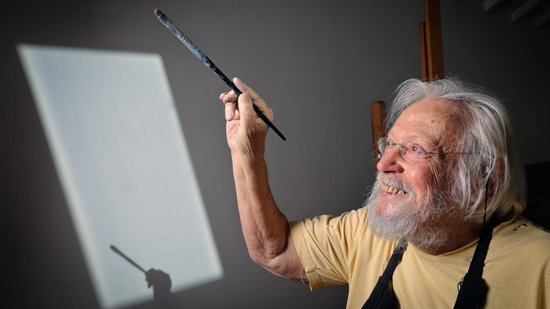
Sara Antónia Matos, director and curator of the Atelier-Museum Júlio Pomar, agreed to choose and comment for the Observer, 10 paradigmatic works of Júlio Pomar. In these choices, which include works from 1946 to 2011, it is possible to observe changes in style and technique, even when the themes are repeated. the portuguese artist Júlio Pomar who studied at the António Arroio School of Decorative Arts and at the Superior School of Fine Arts in Lisbon and Porto, is still recognized today as a neo-realist painter, involved in art as a form of social protest. The “Gadanheiro” and “O Almoço do Trolha” are from this period of protest, paintings with a clear message against the conservatism of the time and the dictatorship. Travel through the career of Júlio Pomar, through the choices of Sara Antónia Matos.
1.Mural for Cinema Batalha, in Porto, 1946-47
“The works of this period are part of the so-called neorealist movement. The artist is arrested by the PIDE, before the mural is completed. The government imposes the definitive elimination of the murals of Cinema Batalha in June 1948, one year after the inauguration of the building. The few photographs that exist today of this painting, made directly on the wall of the building, allow a glimpse of the artist's boldness, at the time without the experience he has today, in accepting a challenge with such artistic and social responsibility.”

2.“Study in Scarlet”, 1964
“The set of works dedicated to the theme of 'races' and 'entries' – namely through the representation of horses, jockeys' races, entrances of bulls and campinos – are, for Pomar, a reason for intense exploration of movement in painting. Júlio Pomar he is on the move and gives movement to his tools. He moves to paint and moves spirits to write. He searches for movement and this, as if it were already escaping his control, gaining autonomy, advances from his canvases towards the spectator’s space.”

3.“Le Bain Turc (d´après Ingres)”, 1968
“It manifests an eruption of the body, sex and eroticism – important axes in the artist’s work –, it is one of the works in which Júlio Pomar assumes, in the title, one of the masters who serve as a reference. Pomar shows that flat color fills shapes, providing them with a precise cut, which is enough to provide structure to the painting. This and other paintings resulting from this phase can be considered the turning point in relation to the painting of the previous phase, where the gesture and the free brushstroke are dominant.”

4.“Tiger”, 1980
“It is one of his paradigmatic works: a symbol of strength and an icon of sensuality and eroticism, in the universe of Júlio Pomar. One cannot, therefore, fail to mention the erotic component in the painter's work, which will be more in the textural dimension, and in the thickness of the pictorial matter that this tiger enacts, than in the explicit and objective figuration of intertwined bodies.”

5.Portrait of President Mário Soares, 1992
“Throughout its entire course, Júlio Pomar he made portraits and self-portraits, and it can be considered that he has always invested in one of the most canonical genres in the history of art. The portrait of Mário Soares is one of the most emblematic, not only because of the new style and informality that it introduces into the gallery of presidential portraits, but also because, in fact, the then president was a longtime friend, having shared episodes and remarkable historical moments, from which is an example of the period of imprisonment, in 1947.”

6.“Masked de Pirenópolis nº 15”, 1987
“Of great chromatic strength, it is part of a series of 15 paintings with the same title in which the painter represents the festivities and rituals associated with the festivities of the Divine Espírito Santo, which he attended in Brazil. This work, as well as the paintings he dedicates to the Indians of the Amazonian community, namely 'Os Ticxão', are large-scale paintings, which can reach four meters in length. They demonstrate how telluric forces are transferred to the support of the canvas.”

7. “Fernando Pessoa” – Alto dos Moinhos metro station, Lisbon, 1983-84
“Camões, Bocage, Almada and Pessoa were chosen by Júlio Pomar to inhabit the Alto dos Moinhos metro station. Pessoa appears in triplicate, duplicated, at the coffee table, shining shoes, alluding to everyday life, along an underground route that many city dwellers take every day. This set of drawings, namely the figure of Pessoa, can be found in different everyday supports: in the passports of Portuguese citizens and in some ATM cards.”

8.Drawings for “War and Peace”, by Tolstoy, 1956-1958
“Illustration work, an example of a fruitful relationship between plastic work and literature. In this domain, the work of Júlio Pomar it acquires a humor and irony that is both biting and amusing. Not subjugating the illustration to the text, the drawings, illustrations and paintings, denote sudden explosions of humor.”

9.“Carlos do Carmo”, 2011
“Underlining the importance of music and poetry, we could not fail to present the paintings that, in the last two decades, Júlio Pomar dedicated to the universe of fado and particularly to its interpreters: Carlos do Carmo, Cristina Branco, Mariza or even Alfredo Marceneiro. In some, he appears alongside Fernando Pessoa, highlighting the importance of the dialogue between 'popular culture' and 'erudite culture'. For the painter, they are two inseparable aspects of culture.”

10.“Donkey Playing Guitar”, 2011
“Within the theme of fado, the representation of the guitar assumes particular relevance because it becomes an instrument of manifestation or entertainment of that animal to which, in recent years, Pomar has dedicated special attention: the donkey. It is depicted from the front (like most animals in Júlio Pomar). Instead of the sad figure we usually know of this animal, its donkeys Júlio Pomar they sing, have fun, carry guitars and carry a fun quixotic sarcasm.”

